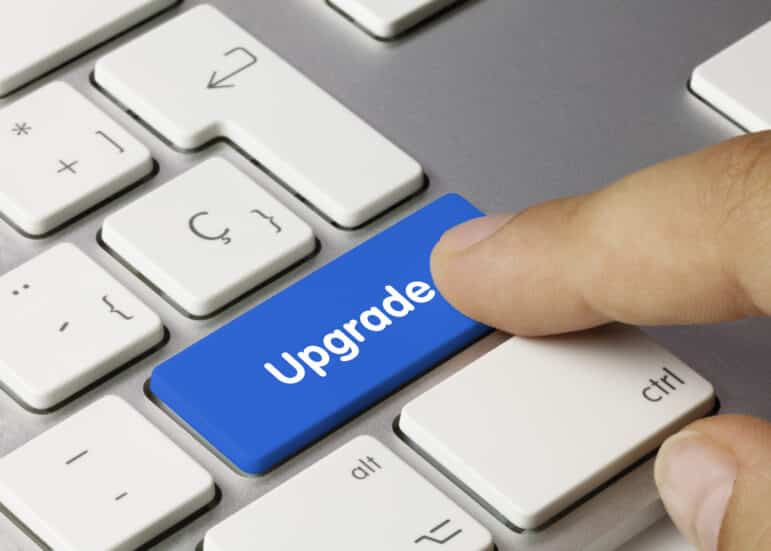Auditing readiness for an ERP upgrade can seem like a daunting task. If you feel like you’re caught in the technological dark ages, you’re not alone. Many companies make the assumption that an upgrade in technology is overwhelming and expensive, so they put off a technological overhaul that could change the future of their company. Many software companies, including Microsoft, continue to invest heavily in easy-to-use, innovative offerings which capitalize on digital transformation trends like SaaS and cloud computing. If you’re wondering if you’re ready for an ERP upgrade, take a look at our ERP Upgrade Readiness Assessment to see where your company stands.

Replace or Upgrade Your ERP Software
Some CFOs can understand operational inefficiencies within their company, and have the knowledge and network to make an informed decision on how to move forward with a technology overhaul, but these are few and far between. As you search for an ERP provider, it is worth taking a few preliminary steps to see what the best course of action is for your specific situation.

If you have a current ERP implementation, it may be worth it to hire a functional ERP consultant who knows their way around your current ERP. A consultant versed in your specific software can easily spot inefficiencies and areas of improvement and create a list or discuss the pros and cons of switching. It is important to note that some consultants may be supported by a specific product, and would therefore be pushing that product above all else. A third-party consultant would be your best and most transparent option here.
It may also be wise to contact similar companies and discuss their implementations. You may find many folks in the space are using outdated systems and are facing the same issue as you. You may also find a similar company is in the middle of, or has just finished, an ERP implementation. The more information you can collect on the process, the better off the implementation will be.
Requirements and Inefficiencies
Auditing and understanding the areas which may complicate an ERP implementation can help things run more smoothly once you move to implement.
ERP Upgrade Obstacles
If the data in your current reports is not lining up with reports for another team, it is worth it to fix these problems upon implementation. Viewing cost restrictions, resource implementation, and risks as an opportunity to improve can change your approach to the project all the way around. These direct changes can have an immediate positive impact on your bottom line.
Determining What is in Use
As you look to implement an upgraded ERP system, it is a good time to take a hard look at your current licenses and compare that with the ERP modules which are currently in use. Understanding the functionality and potential for each module can lead to not only success in implementation, but to a comprehensive understanding of the intended functionality of your software.
 Business Processes & Functionality
Business Processes & Functionality
Companies change over time. Maybe you offer twice as many products as you did when you originally implemented your (now outdated) ERP system. Maybe you’ve expanded to a new location requiring a different set of parameters. Maybe you are looking to expand into a new vertical in coming months or years. All of these factors should be considered in an ERP implementation. Taking a moment to look from a top level perspective can shed some further light on the needs for your software system.
Policies, Procedures, & Documentation
Creating and implementing procedures related to company changes can help your software evolve as you do. Writing out and keeping track of business processes allows you to quickly implement changes without having to wait for other teams to catch up, or keeps you from dropping the ball altogether.
Workflow Analyzation
As with the business processes and procedural sections above, this is a great opportunity to audit operational efficiencies and inefficiencies in the form of workflow analysis. There is a good chance there are many processes which haven’t been audited in quite some time. Stepping back to understand where things can be improved will not only help your ERP implementation, but your overall business processes as well.
Organizational Readiness
The first internal step once you’ve decided to upgrade your ERP is to gain internal buy in. Many enterprise software projects fail because they don’t have full buy-in from the executive team. The mentality surrounding a software implementation must be developed around strategic initiatives which will provide direct value to a company in the form of efficiency, reporting, and accountability across many disciplines in the business. A fully prepared ERP software implementation project should have the following:
- Ongoing executive involvement
- Clear project goals that align with business goals
- Adequate time, budget and resources
- Plans to manage change
- Ways to hold people accountable
- Adoption of industry best practices
Before beginning, ensure the best people involved will have the time to commit to this project.
Author: Doug Bulla, VP of Solution Development
Other articles you might be interested in:
{% set pop_posts = blog_popular_posts(‘default’, 3, ‘ERP’) %} {% for pop_post in pop_posts %}
{% endfor %}

